How to adjust a washing machine so it doesn't jump
Almost everyone who uses a washing machine knows about its habit of jumping up and moving out of its place during the spin process. This article will discuss the causes of the phenomenon and methods of preventing them.
Let's look at the reasons first. They can be divided into two groups:
- factors causing vibration;
- factors that allow movement on the floor.
The content of the article
Why does the washing machine jump?
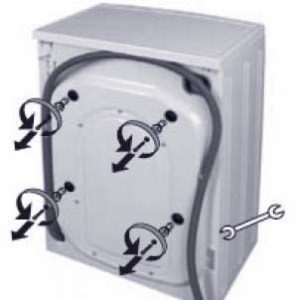 The first cause of strong vibrations may be undismantled transport bolts. They firmly fix the tank inside the housing so as not to damage it during transportation. Before starting work, bolts and other fixing elements must be removed. It is strictly prohibited to operate the machine with them.
The first cause of strong vibrations may be undismantled transport bolts. They firmly fix the tank inside the housing so as not to damage it during transportation. Before starting work, bolts and other fixing elements must be removed. It is strictly prohibited to operate the machine with them.
The next reason for vibration is uneven distribution of things in the tank. If you start the device with an empty tank, it will not vibrate. The same thing will happen if you distribute things perfectly evenly - in an even layer around the entire circumference of the tank. In reality, such a distribution is impossible to achieve; even those evenly distributed at the beginning are mixed during the washing process.
Faulty tank suspension and support bearings. Loosening of the counterweight.
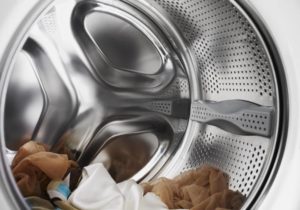 The purpose of the system of springs, dampers and counterweight is to make the natural frequency of the tank much lower than the frequency of its rotation. This reduces the amplitude of vibrations and the amount of vibration transmitted to the body.
The purpose of the system of springs, dampers and counterweight is to make the natural frequency of the tank much lower than the frequency of its rotation. This reduces the amplitude of vibrations and the amount of vibration transmitted to the body.
To better understand the content of the previous paragraph, remember: at the beginning of the spin cycle, the body of the loaded machine sways more strongly, and then, with an increase in the rotation speed of the tank, the swaying turns into a slight trembling or, with the correct distribution of the laundry, practically disappears.
Swing the tank - after that it should make no more than one oscillation and stop. Otherwise, the shock absorbers are faulty and must be replaced.
Open the casing, inspect the elastic elements - metal ones should not have deformations, rubber ones should not have tears or cracks. Defective parts must be replaced! Check the counterweight fastening - if it is loose, tighten the nuts.
Faulty bearings. There should be no squeaks or knocks when the equipment is operating. Rotate the tank by hand and rock it from side to side. If you detect squeaking or beating, replace the faulty parts.
Correct installation of the washing machine
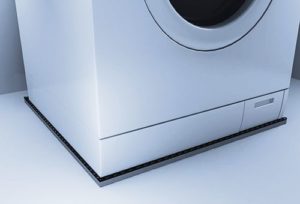 First requirement for installation - horizontal floor. When deviating from horizontal, the vibrating machine will slide in the direction of the slope. If the floor is not ideal, you need to build some kind of podium that creates a horizontal surface. At the same time, it itself should not slide on the floor surface.
First requirement for installation - horizontal floor. When deviating from horizontal, the vibrating machine will slide in the direction of the slope. If the floor is not ideal, you need to build some kind of podium that creates a horizontal surface. At the same time, it itself should not slide on the floor surface.
Second requirement – horizontality of the equipment itself. Or verticality. It depends on what is chosen as the criterion: the top plane must be strictly horizontal, any side edge must be vertical.
Why is this necessary? Even with the most careful distribution of things, they will move during the washing process and create a beating when the tank rotates quickly. In an unevenly parked machine, the beats will deviate from the calculated ones and, as a result of the uneven load on the supports, can cause displacement.
Is the impact of deviation significant? It’s better not to analyze it, but simply level the car. This is not such a difficult operation.
How to level a car? What will be needed for adjustment?
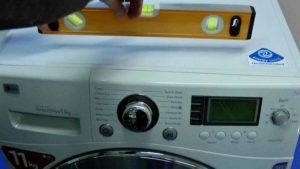 Before starting work, prepare a level approximately 1 meter long. No longer needed. If there is no such long one, we will take what is available. But we must keep in mind that the shorter the level, the less accuracy.
Before starting work, prepare a level approximately 1 meter long. No longer needed. If there is no such long one, we will take what is available. But we must keep in mind that the shorter the level, the less accuracy.
You will also need two open-end wrenches. The size must match the adjusting nuts on the legs of the washer.
Step-by-step instructions for installing a washing machine
Checking the platform for horizontality, on which the device will stand. In fact, it is not the horizontality of the entire platform that is important, but the plane passing through the spots on which the legs will rest.
Using a level, we check the horizontality of the site along both diagonals. If horizontality is maintained here, we check along two adjacent sides. If everything is in order here, we place the car with its feet on the proven platforms. If the floor is not horizontal in any direction, we place stands on low places, achieving horizontality in all directions.
Stands can be made from any flat and hard material. It is recommended to stick a thin sheet of rubber on the side in contact with the floor. Its purpose will be described below.
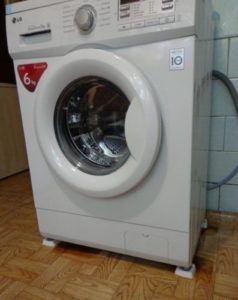 Now we place the washing machine on the platform or on stands. By adjusting the height of the legs, we achieve horizontality of the upper surface.We check the correct installation of the verticality of the side ribs.
Now we place the washing machine on the platform or on stands. By adjusting the height of the legs, we achieve horizontality of the upper surface.We check the correct installation of the verticality of the side ribs.
If everything is fine, tighten the locking nuts on the adjusting screws of the legs and check again whether the vertical-horizontal alignment has been disturbed during locking.
Now try to rock the car left and right and diagonally. If it doesn’t sway—not almost, but doesn’t sway at all—that means it’s positioned correctly.
But there is one more nuance. As already noted, it is almost impossible to completely eliminate vibrations, so there is always the possibility of equipment leaving its rightful place.
 Remember when they used to put a sheet of rubber on the footrests? This is so that with small vibrations they do not slip on the floor and do not allow them to move.
Remember when they used to put a sheet of rubber on the footrests? This is so that with small vibrations they do not slip on the floor and do not allow them to move.
Find a rectangular sheet of rubber 1–1.5 cm thick, and about 5 cm larger than the size of the machine. The hardness should be such that the legs will penetrate it by about half the thickness. Place it on a horizontal surface under the car, and the likelihood of it leaving will be reduced to zero.
Operating tips to reduce vibration
Do not overload the drum when washing. The suspension system is designed to work with a certain load. Excess will lead to excessive vibrations, and in the long term to premature failure of components.
Before starting, distribute things evenly around the circumference of the drum. There are models that can do this on their own, but still help them - artificial intelligence is not that smart yet.
If your machine is a top-loader, you can keep something heavy on it, such as a laundry basket. This will increase resistance to vibration.
Place the machine at a distance of at least 5 cm from the walls so that in an emergency it does not damage them or itself.
Conclusion
At the end, we will briefly list what was discussed in the article:
- Don't forget dinstall transport bolts;
- The equipment must be on horizontal surface and strictly vertically;
- Place a rubber mat under the legs;
- Evenly distribute things around the circumference of the drum;
- Don't overload drum;
- Provide a gap between the wall and the machine not less than 5 cm;
- Attention! Never use faulty equipment. If an elastic element breaks or a bearing breaks while running, the damage can reach such proportions that the extra washed shirt will turn out to be gold.




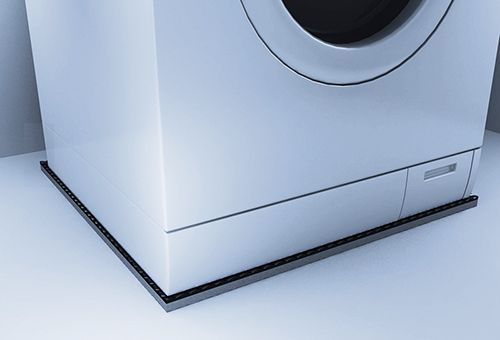

How to get rid of vibration in a washing machine.